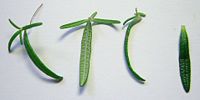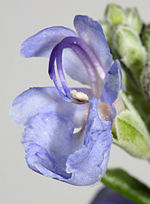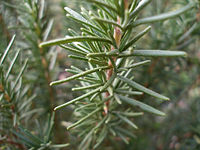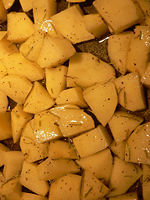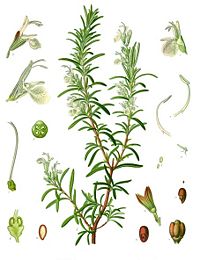Difference between revisions of "Rosemary" - New World Encyclopedia
Rick Swarts (talk | contribs) |
Rosie Tanabe (talk | contribs) |
||
| (24 intermediate revisions by 4 users not shown) | |||
| Line 1: | Line 1: | ||
| + | {{Images OK}}{{Approved}}{{Copyedited}} | ||
{{taxobox | {{taxobox | ||
|name = Rosemary | |name = Rosemary | ||
| Line 13: | Line 14: | ||
|species = '''''R. officinalis''''' | |species = '''''R. officinalis''''' | ||
|binomial = ''Rosmarinus officinalis'' | |binomial = ''Rosmarinus officinalis'' | ||
| − | |binomial_authority = [[Carolus Linnaeus|L.]] | + | |binomial_authority = [[Carolus Linnaeus|L.]] |
| − | |||
| − | |||
| − | |||
| − | |||
| − | |||
| − | |||
| − | |||
|}} | |}} | ||
| − | '''Rosemary''' is the common name for a woody, [[perennial plant|perennial]] [[herbaceous plant]], '''''Rosmarinus officinalis''''', characterized by fragrant, [[evergreen]] needle-like [[leaf|leaves]] and tiny, clustered, light blue, violet, pink, or white [[flower]]s. The name also refers specifically to the aromatic leaves of this plant, which are used as a [[herb]] for seasoning various dishes and used in | + | '''Rosemary''' is the common name for a woody, [[perennial plant|perennial]] [[herbaceous plant]], '''''Rosmarinus officinalis''''', characterized by fragrant, [[evergreen]] needle-like [[leaf|leaves]] and tiny, clustered, light blue, violet, pink, or white [[flower]]s. The name also refers specifically to the aromatic leaves of this plant, which are used as a [[herb]] for seasoning various dishes and used in [[perfume]]s. A member of the mint family, [[Lamiaceae]], rosemary is native to the [[Mediterranean region]]. |
| − | Rosemary is widely cultivated for culinary and medicinal use | + | Rosemary is widely cultivated for culinary and medicinal use. It is used in a wide variety of dishes, including as a meat seasoning (lamb, poultry), to add flavor to soups and vegetables, and in fruit salads, dressings, and stuffings. As reflected by the name ''officinalis,'' it is known as a medicinal herb, with a long history of use in the West, including [[nervous system]] ailments. Queen Isabella of Hungary in the fourteenth century used rosemary to treat [[gout]] and rosemary has been burned in sick rooms as a disinfectant. Its aromatic properties are used to scent cosmetics. |
| + | {{toc}} | ||
| + | Known as "herb of remembrance," rosemary also has long been tied to legends and traditions. [[Pharaoh]]s were buried with the herb in ancient [[Egypt]], Greek scholars use rosemary to aid study, and young brides have traditionally carried a sprig of rosemary in wedding bouquets and wreaths. It has been exchanged as a symbol of loyalty between friends and tossed onto a loved one's grave. | ||
| − | + | Ecologically, rosemary provides nectar and pollen to [[pollination|pollinating]] [[bee]]s. | |
==Description== | ==Description== | ||
| − | There are a number of varieties of rosemary, ''Rosmarinus officinalis'' | + | [[Image:Rosemary 'Irene' leaves.jpg|thumb|right|200px|Leaves, the lighter side is the underside, and some have parts of young shoots or old stem attached]] |
| + | There are a number of varieties of rosemary, ''Rosmarinus officinalis,'' ranging from upright to trailing forms. The upright varieties can reach 1.5 meters (4 feet, 11 inches) tall, rarely 2 meters (6 feet, 7 inches) in favorable settings. It has a deep taproot and stout, branching, scaly, stalks. | ||
| − | The leaves are evergreen, simple, sessile, and opposite. They are narrow leaves, about 2 to 4 centimeters (0.79–1.6 inches) long and 2 to 5 millimeters (0.08-0.2 inches) broad. The leaves are dark green above and pale green on the underside, with a distinctive mid vein (Hanrahan and Frey 2005). | + | [[Image:RoseMaryCLoseUp.jpg|thumb|left|150px|Close up of flower]] |
| + | The leaves are evergreen, simple, sessile, and opposite. They are narrow leaves, about 2 to 4 centimeters (0.79–1.6 inches) long and 2 to 5 millimeters (0.08-0.2 inches) broad. The leaves are dark green above and pale green on the underside, with a distinctive mid vein (Hanrahan and Frey 2005). They curl inward at the margins and have dense short woolly hair (Hanrahan and Frey 2005). | ||
| + | [[Image:Rosemarymacro.jpg|thumb|right|200px|Close up of specimen]] | ||
The [[flower]]s appear in winter or spring and are variable in color, being white, pink, purple, or blue. They are tiny, two-lipped, and grow in a cluster of five to seven blossoms each from a pair of short, opposite spikes that alternate along the sides of the stalk (Hanrahan and Frey 2005). Two seeds are borne in each flower (Hanrahan and Frey 2005). | The [[flower]]s appear in winter or spring and are variable in color, being white, pink, purple, or blue. They are tiny, two-lipped, and grow in a cluster of five to seven blossoms each from a pair of short, opposite spikes that alternate along the sides of the stalk (Hanrahan and Frey 2005). Two seeds are borne in each flower (Hanrahan and Frey 2005). | ||
| − | The name ''rosemary'' has nothing to do with the [[rose]] or the name [[Mary]], but derives from the [[Latin]] name ''ros marinus'' | + | The name ''rosemary'' has nothing to do with the [[rose]] or the name [[Mary]], but derives from the [[Latin]] name ''ros marinus,'' which literally means "dew of the sea." The plant does grown wild on rocky, dry slopes near the sea (Hanrahan and Frey 2005). Other common names include '''polar plant''', '''compass plant''', and '''compass-weed''' (Hanrahan and Frey 2005). |
==Cultivation== | ==Cultivation== | ||
| − | + | Rosemary grows wild in the Mediterranean area, where it is native. It is now cultivated throughout Europe and the United States (Herbst 2001), with France, Spain, and California the main producing areas. Rosemary thrives in sandy or [[chalk]]y soil in full sun (Hanrahan and Frey 2005). It does not tolerate strong frosts, but does do well in most temperate areas. | |
| − | Rosemary is easily pruned into shapes and has been used for [[topiary]]. When grown in pots, it is best kept trimmed to stop it getting straggly and unsightly, though when grown in a garden, rosemary can grow quite large and still be attractive. It can be propagated from an existing plant by clipping a shoot | + | Since rosemary is attractive and tolerates some degree of [[drought]], it is also used in [[landscaping]], especially in areas having a [[Mediterranean climate]]. It is considered easy to grow for beginner gardeners, and is pest-resistant. |
| + | |||
| + | Rosemary is easily pruned into shapes and has been used for [[topiary]]. When grown in pots, it is best kept trimmed to stop it getting straggly and unsightly, though when grown in a garden, rosemary can grow quite large and still be attractive. It can be propagated from an existing plant by clipping a shoot 10 to 15 centimeters (3.9–5.9 inches) long, stripping a few leaves from the bottom, and planting it directly into soil. | ||
Numerous [[cultivar]]s have been selected for [[garden]] use. The following are frequently sold: | Numerous [[cultivar]]s have been selected for [[garden]] use. The following are frequently sold: | ||
| Line 63: | Line 64: | ||
== Usage == | == Usage == | ||
| + | Rosemary is cultivated for its aromatic and medicinal properties, and is widely used in perfumes and various dishes. | ||
| + | |||
=== Culinary use === | === Culinary use === | ||
| − | The fresh and dried leaves are used frequently in traditional [[Mediterranean cuisine]] as a [[herb]] | + | [[Image:Rosemary potatoes.jpg|thumb|right|150px|Rosemary potatoes]] |
| + | The fresh and dried leaves of rosemary are used frequently in traditional [[Mediterranean cuisine]] as a [[herb]]. The leaves have a bitter, astringent taste, which complements a wide variety of foods. | ||
| + | |||
| + | The herb can be obtained in whole-leaf form, fresh or dried, as well as in powdered form. A [[tisane]] can also be made from them. When burned they give off a distinct mustard smell, as well as a smell similar to that of burning which can be used to flavor foods while barbecuing. | ||
| + | |||
| + | Among dishes where rosemary is used as a seasoning are soups, vegetables, meats such as lamb, fish and egg dishes, stuffings and dressings, and fruit salads (Herbst 2001). | ||
| − | Rosemary is extremely high in [[iron]], [[calcium]], and [[Vitamin B6]]. | + | Rosemary is extremely high in [[iron]], [[calcium]], and [[Vitamin B6]] (ND 2008). |
| − | === | + | === Medicinal use === |
| − | [[Hungary | + | [[Image:Koeh-258.jpg|thumb|right|200px|From Koehler's Medicinal Plants, 1887]] |
| + | Rosemary has been used medicinal for long time. [[Hungary water]], an alcohol-based perfume involving distilled fresh rosemary, was traditionally believed to have been first prepared for the Queen of Hungary in the fourteenth century to "renovate vitality of paralyzed limbs" and to treat gout. It was used externally and prepared by mixing fresh rosemary tops into spirits of wine or brandy. It has been used to ward off the plague and burned in sick rooms as a disinfectant. | ||
| − | [[ | + | Long used medicinally in the West, and called a "sovereign balm' by seventeenth-century [[herbalist]] [[Nicholas Culpeper]], it has been used as a circulatory stimulant (treatment of blood pressure problems), [[antibacterial]] and antifungal oil, digestive stimulant, liver tonic, reduction of excessive menstrual flow, and is said to have [[cancer]]-inhibiting effects ((Hanrahan and Frey 2005). |
| − | Rosemary has a very old reputation for improving [[memory]], and has been used as a symbol for remembrance (during weddings, war commemorations and funerals) in Europe. | + | Rosemary has a very old reputation for improving [[memory]], and has been used as a symbol for remembrance (during weddings, war commemorations, and funerals) in Europe. Mourners would throw it into graves as a symbol of remembrance for the dead. Greek scholars would wear some of the pungent herb in their hair during study to increase concentration (Hanrahan and Frey 2005). In [[William Shakespeare|Shakespeare's]] ''[[Hamlet]],'' [[Ophelia (character)|Ophelia]] says, "There's rosemary, that's for remembrance." (Hamlet, iv. 5.) One modern study lends some credence to this reputation. When the smell of rosemary was pumped into cubicles where people were working, those people showed improved memory, though with slower recall (Moss et al. 2003). |
| − | + | Rosemary contains a number of potentially biologically active compounds, including [[antioxidant]]s such as carnosic acid and [[rosmarinic acid]]. Other bioactive compounds include [[caffeic acid]], [[ursolic acid]], [[betulinic acid]], [[rosmaridiphenol]], and [[rosmanol]]. The results of a study suggest that [[carnosic acid]], found in rosemary, may shield the [[brain]] from free radicals, lowering the risk of [[stroke]]s and neurodegenerative diseases like Alzheimer's and Lou Gehrig's (BIMR 2007). | |
| − | The results of a study suggest that [[carnosic acid]], found in rosemary, may shield the brain from free radicals, lowering the risk of | ||
| − | + | ===== Health Precautions ===== | |
| − | + | Rosemary in culinary or therapeutic doses is generally safe; however, precaution is necessary for those displaying [[allergy|allergic]] reaction or prone to [[epileptic seizure]]s. Rosemary [[essential oil]] may have epileptogenic properties, as a handful of case reports over the past century have linked its use with seizures in otherwise healthy adults or children (Burkhard et al. 1999). | |
| − | Rosemary | + | Rosemary essential oil is potentially toxic if ingested. Large quantities of rosemary leaves can cause adverse reactions, such as coma, spasm, vomiting, and pulmonary edema (fluid in the lungs) that can be fatal. One should avoid consuming large quantities of rosemary if pregnant or breastfeeding, although small quantities to season foods are considered safe (Hanrahan and Frey 2005). |
| − | < | + | ==Gallery== |
| − | Rosemary | + | <gallery> |
| + | Image:Rosemary white bg.jpg|Rosemary sprig | ||
| + | Image:ChristianBauer flowering rosemary.jpg|Flower | ||
| + | Image:Rosemary.jpg|A rosemary bush with many flowers | ||
| + | Image:Rosemary 'Irene'.jpg|A shoot of the cultivar 'Irene' | ||
| + | Image:Rosmarinus officinalis.jpg|A rosemary bush at [[Longwood Gardens]] | ||
| + | Image:Large_rosemary_bush.jpg|Huge specimen in [[Sebastopol, CA]], roughly 2.2 meters in height | ||
| + | </gallery> | ||
==References== | ==References== | ||
| − | * Hanrahan, C. and R. J. Frey. 2005. | + | * Burkhard, P. R., K. Burkhardt, C.-A. Haenggeli, and T. Landis. 1999. [http://www.springerlink.com/content/ycpbv6cvejrtlplx/ Plant-induced seizures: reappearance of an old problem]. ''Journal of Neurology'' 246(8): 667–670. PMID 10460442. Retrieved January 1, 2009. |
| + | |||
| + | * Burnham Institute for Medical Research (BIMR). 2007. [http://www.sciencedaily.com/releases/2007/10/071030102210.htm Rosemary chicken protects your brain from free radicals]. ''ScienceDaily'' November 2, 2007. Retrieved January 1, 2009. | ||
| + | |||
| + | * Calabrese, V., G. Scapagnini, C. Catalano, F. Dinotta, D. Geraci, and P. Morganti. 2000. [http://www.ncbi.nlm.nih.gov/pubmed/10937349 Biochemical studies of a natural antioxidant isolated from rosemary and its application in cosmetic dermatology]. ''International Journal of Tissue Reactions'' 22(1): 5–13. PMID 10937349. Retrieved January 1, 2009. | ||
| + | |||
| + | * Hanrahan, C. and R. J. Frey. 2005. Rosemary. In J. L. Longe, ed. ''The Gale Encyclopedia of Alternative Medicine.'' Farmington Hills, MI: Thomson/Gale. ISBN 0787693960. | ||
| + | |||
* Herbst, S. T. 2001. ''The New Food Lover's Companion: Comprehensive Definitions of Nearly 6,000 Food, Drink, and Culinary Terms. Barron's Cooking Guide.'' Hauppauge, NY: Barron's Educational Series. ISBN 0764112589. | * Herbst, S. T. 2001. ''The New Food Lover's Companion: Comprehensive Definitions of Nearly 6,000 Food, Drink, and Culinary Terms. Barron's Cooking Guide.'' Hauppauge, NY: Barron's Educational Series. ISBN 0764112589. | ||
| − | + | * Huang, M. T., C.-T. Ho, Z. Y. Wang, et al. 1994. [http://cancerres.aacrjournals.org/cgi/content/abstract/54/3/701 Inhibition of skin tumorigenesis by rosemary and its constituents carnosol and ursolic acid]. ''Cancer Research'' 54(3): 701–708. PMID 8306331. Retrieved January 1, 2009. | |
| − | * | + | |
| − | + | * Moss, M., J. Cook, K. Wesnes, and P. Ducket. 2003. [http://www.informaworld.com/smpp/content~db=all?content=10.1080/00207450390161903 Aromas of rosemary and lavender essential oils differentially affect cognition and mood in healthy adults]. ''International Journal of Neuroscience'' 113(1): 15–38. Retrieved January 1, 2009. | |
| − | + | ||
| + | * Nutrition Data (ND). 2008. [http://www.nutritiondata.com/facts-C00001-01c203K.html Spices, rosemary, dried]. ''Nutrition Data''. Retrieved January 1, 2009. | ||
== External links == | == External links == | ||
| − | + | All links retrieved December 16, 2022. | |
| − | + | ||
| − | + | * [http://botanical.com/botanical/mgmh/r/rosema17.html Rosemary medicinal use: botanical.com] | |
| − | |||
| − | * [http://botanical.com/botanical/mgmh/r/rosema17.html medicinal use: botanical.com | ||
| − | |||
| − | |||
| − | |||
* [http://www.ourherbgarden.com/herb-history/rosemary.html History of Rosemary] | * [http://www.ourherbgarden.com/herb-history/rosemary.html History of Rosemary] | ||
| − | + | ||
| − | + | ||
| − | |||
| − | |||
| − | |||
| − | |||
| − | |||
| − | |||
| − | |||
| − | |||
| − | |||
| − | |||
| − | |||
| − | |||
{{Herbs & spices}} | {{Herbs & spices}} | ||
Latest revision as of 19:17, 16 December 2022
| Rosemary | ||||||||||||||
|---|---|---|---|---|---|---|---|---|---|---|---|---|---|---|
 Rosemary in flower
| ||||||||||||||
|
Secure
| ||||||||||||||
| Scientific classification | ||||||||||||||
| ||||||||||||||
| Rosmarinus officinalis L. |
Rosemary is the common name for a woody, perennial herbaceous plant, Rosmarinus officinalis, characterized by fragrant, evergreen needle-like leaves and tiny, clustered, light blue, violet, pink, or white flowers. The name also refers specifically to the aromatic leaves of this plant, which are used as a herb for seasoning various dishes and used in perfumes. A member of the mint family, Lamiaceae, rosemary is native to the Mediterranean region.
Rosemary is widely cultivated for culinary and medicinal use. It is used in a wide variety of dishes, including as a meat seasoning (lamb, poultry), to add flavor to soups and vegetables, and in fruit salads, dressings, and stuffings. As reflected by the name officinalis, it is known as a medicinal herb, with a long history of use in the West, including nervous system ailments. Queen Isabella of Hungary in the fourteenth century used rosemary to treat gout and rosemary has been burned in sick rooms as a disinfectant. Its aromatic properties are used to scent cosmetics.
Known as "herb of remembrance," rosemary also has long been tied to legends and traditions. Pharaohs were buried with the herb in ancient Egypt, Greek scholars use rosemary to aid study, and young brides have traditionally carried a sprig of rosemary in wedding bouquets and wreaths. It has been exchanged as a symbol of loyalty between friends and tossed onto a loved one's grave.
Ecologically, rosemary provides nectar and pollen to pollinating bees.
Description
There are a number of varieties of rosemary, Rosmarinus officinalis, ranging from upright to trailing forms. The upright varieties can reach 1.5 meters (4 feet, 11 inches) tall, rarely 2 meters (6 feet, 7 inches) in favorable settings. It has a deep taproot and stout, branching, scaly, stalks.
The leaves are evergreen, simple, sessile, and opposite. They are narrow leaves, about 2 to 4 centimeters (0.79–1.6 inches) long and 2 to 5 millimeters (0.08-0.2 inches) broad. The leaves are dark green above and pale green on the underside, with a distinctive mid vein (Hanrahan and Frey 2005). They curl inward at the margins and have dense short woolly hair (Hanrahan and Frey 2005).
The flowers appear in winter or spring and are variable in color, being white, pink, purple, or blue. They are tiny, two-lipped, and grow in a cluster of five to seven blossoms each from a pair of short, opposite spikes that alternate along the sides of the stalk (Hanrahan and Frey 2005). Two seeds are borne in each flower (Hanrahan and Frey 2005).
The name rosemary has nothing to do with the rose or the name Mary, but derives from the Latin name ros marinus, which literally means "dew of the sea." The plant does grown wild on rocky, dry slopes near the sea (Hanrahan and Frey 2005). Other common names include polar plant, compass plant, and compass-weed (Hanrahan and Frey 2005).
Cultivation
Rosemary grows wild in the Mediterranean area, where it is native. It is now cultivated throughout Europe and the United States (Herbst 2001), with France, Spain, and California the main producing areas. Rosemary thrives in sandy or chalky soil in full sun (Hanrahan and Frey 2005). It does not tolerate strong frosts, but does do well in most temperate areas.
Since rosemary is attractive and tolerates some degree of drought, it is also used in landscaping, especially in areas having a Mediterranean climate. It is considered easy to grow for beginner gardeners, and is pest-resistant.
Rosemary is easily pruned into shapes and has been used for topiary. When grown in pots, it is best kept trimmed to stop it getting straggly and unsightly, though when grown in a garden, rosemary can grow quite large and still be attractive. It can be propagated from an existing plant by clipping a shoot 10 to 15 centimeters (3.9–5.9 inches) long, stripping a few leaves from the bottom, and planting it directly into soil.
Numerous cultivars have been selected for garden use. The following are frequently sold:
- Albus- white flowers
- Arp- leaves light green, lemon-scented
- Aureus- leaves speckled yellow
- Benenden Blue - leaves narrow, dark green tibak
- Blue Boy - dwarf, small leaves
- Golden Rain - leaves green, with yellow streaks
- Irene - lax, trailing
- Lockwood de Forest - procumbent selection from Tuscan Blue
- Ken Taylor - shrubby
- Majorica Pink - pink flowers
- Miss Jessop's Upright - tall, erect
- Pinkie - pink flowers
- Prostratus
- Pyramidalis (a.k.a Erectus) - pale blue flowers
- Roseus - pink flowers
- Salem - pale blue flowers, cold hardy similar to Arp
- Severn Sea - spreading, low-growing, with arching branches; flowers deep violet
- Tuscan Blue - upright
Usage
Rosemary is cultivated for its aromatic and medicinal properties, and is widely used in perfumes and various dishes.
Culinary use
The fresh and dried leaves of rosemary are used frequently in traditional Mediterranean cuisine as a herb. The leaves have a bitter, astringent taste, which complements a wide variety of foods.
The herb can be obtained in whole-leaf form, fresh or dried, as well as in powdered form. A tisane can also be made from them. When burned they give off a distinct mustard smell, as well as a smell similar to that of burning which can be used to flavor foods while barbecuing.
Among dishes where rosemary is used as a seasoning are soups, vegetables, meats such as lamb, fish and egg dishes, stuffings and dressings, and fruit salads (Herbst 2001).
Rosemary is extremely high in iron, calcium, and Vitamin B6 (ND 2008).
Medicinal use
Rosemary has been used medicinal for long time. Hungary water, an alcohol-based perfume involving distilled fresh rosemary, was traditionally believed to have been first prepared for the Queen of Hungary in the fourteenth century to "renovate vitality of paralyzed limbs" and to treat gout. It was used externally and prepared by mixing fresh rosemary tops into spirits of wine or brandy. It has been used to ward off the plague and burned in sick rooms as a disinfectant.
Long used medicinally in the West, and called a "sovereign balm' by seventeenth-century herbalist Nicholas Culpeper, it has been used as a circulatory stimulant (treatment of blood pressure problems), antibacterial and antifungal oil, digestive stimulant, liver tonic, reduction of excessive menstrual flow, and is said to have cancer-inhibiting effects ((Hanrahan and Frey 2005).
Rosemary has a very old reputation for improving memory, and has been used as a symbol for remembrance (during weddings, war commemorations, and funerals) in Europe. Mourners would throw it into graves as a symbol of remembrance for the dead. Greek scholars would wear some of the pungent herb in their hair during study to increase concentration (Hanrahan and Frey 2005). In Shakespeare's Hamlet, Ophelia says, "There's rosemary, that's for remembrance." (Hamlet, iv. 5.) One modern study lends some credence to this reputation. When the smell of rosemary was pumped into cubicles where people were working, those people showed improved memory, though with slower recall (Moss et al. 2003).
Rosemary contains a number of potentially biologically active compounds, including antioxidants such as carnosic acid and rosmarinic acid. Other bioactive compounds include caffeic acid, ursolic acid, betulinic acid, rosmaridiphenol, and rosmanol. The results of a study suggest that carnosic acid, found in rosemary, may shield the brain from free radicals, lowering the risk of strokes and neurodegenerative diseases like Alzheimer's and Lou Gehrig's (BIMR 2007).
Health Precautions
Rosemary in culinary or therapeutic doses is generally safe; however, precaution is necessary for those displaying allergic reaction or prone to epileptic seizures. Rosemary essential oil may have epileptogenic properties, as a handful of case reports over the past century have linked its use with seizures in otherwise healthy adults or children (Burkhard et al. 1999).
Rosemary essential oil is potentially toxic if ingested. Large quantities of rosemary leaves can cause adverse reactions, such as coma, spasm, vomiting, and pulmonary edema (fluid in the lungs) that can be fatal. One should avoid consuming large quantities of rosemary if pregnant or breastfeeding, although small quantities to season foods are considered safe (Hanrahan and Frey 2005).
Gallery
ReferencesISBN links support NWE through referral fees
- Burkhard, P. R., K. Burkhardt, C.-A. Haenggeli, and T. Landis. 1999. Plant-induced seizures: reappearance of an old problem. Journal of Neurology 246(8): 667–670. PMID 10460442. Retrieved January 1, 2009.
- Burnham Institute for Medical Research (BIMR). 2007. Rosemary chicken protects your brain from free radicals. ScienceDaily November 2, 2007. Retrieved January 1, 2009.
- Calabrese, V., G. Scapagnini, C. Catalano, F. Dinotta, D. Geraci, and P. Morganti. 2000. Biochemical studies of a natural antioxidant isolated from rosemary and its application in cosmetic dermatology. International Journal of Tissue Reactions 22(1): 5–13. PMID 10937349. Retrieved January 1, 2009.
- Hanrahan, C. and R. J. Frey. 2005. Rosemary. In J. L. Longe, ed. The Gale Encyclopedia of Alternative Medicine. Farmington Hills, MI: Thomson/Gale. ISBN 0787693960.
- Herbst, S. T. 2001. The New Food Lover's Companion: Comprehensive Definitions of Nearly 6,000 Food, Drink, and Culinary Terms. Barron's Cooking Guide. Hauppauge, NY: Barron's Educational Series. ISBN 0764112589.
- Huang, M. T., C.-T. Ho, Z. Y. Wang, et al. 1994. Inhibition of skin tumorigenesis by rosemary and its constituents carnosol and ursolic acid. Cancer Research 54(3): 701–708. PMID 8306331. Retrieved January 1, 2009.
- Moss, M., J. Cook, K. Wesnes, and P. Ducket. 2003. Aromas of rosemary and lavender essential oils differentially affect cognition and mood in healthy adults. International Journal of Neuroscience 113(1): 15–38. Retrieved January 1, 2009.
- Nutrition Data (ND). 2008. Spices, rosemary, dried. Nutrition Data. Retrieved January 1, 2009.
External links
All links retrieved December 16, 2022.
| Herbs and spices | |
|---|---|
| Herbs | Angelica • Basil • Basil, holy • Basil, Thai • Bay leaf • Boldo • Borage • Cannabis • Chervil • Chives • Coriander leaf (cilantro) • Curry leaf • Dill • Epazote • Eryngium foetidum (long coriander) • Hoja santa • Houttuynia cordata (giấp cá) • Hyssop • Lavender • Lemon balm • Lemon grass • Lemon verbena • Limnophila aromatica (rice paddy herb) • Lovage • Marjoram • Mint • Mitsuba • Oregano • Parsley • Perilla (shiso) • Rosemary • Rue • Sage • Savory • Sorrel • Stevia • Tarragon • Thyme • Vietnamese coriander (rau răm) • Woodruff |
| Spices | African pepper • Ajwain (bishop's weed) • Aleppo pepper • Allspice • Amchur (mango powder) • Anise • Aromatic ginger • Asafoetida • Camphor • Caraway • Cardamom • Cardamom, black • Cassia • Cayenne pepper • Celery seed • Chili • Cinnamon • Clove • Coriander seed • Cubeb • Cumin • Cumin, black • Dill seed • Fennel • Fenugreek • Fingerroot (krachai) • Galangal, greater • Galangal, lesser • Garlic • Ginger • Grains of Paradise • Horseradish • Juniper berry • Liquorice • Mace • Mahlab • Malabathrum (tejpat) • Mustard, black • Mustard, brown • Mustard, white • Nasturtium • Nigella (kalonji) • Nutmeg • Paprika • Pepper, black • Pepper, green • Pepper, long • Pepper, pink, Brazilian • Pepper, pink, Peruvian • Pepper, white • Pomegranate seed (anardana) • Poppy seed • Saffron • Sarsaparilla • Sassafras • Sesame • Sichuan pepper (huājiāo, sansho) • Star anise • Sumac • Tasmanian pepper • Tamarind • Turmeric • Wasabi • Zedoary |
Credits
New World Encyclopedia writers and editors rewrote and completed the Wikipedia article in accordance with New World Encyclopedia standards. This article abides by terms of the Creative Commons CC-by-sa 3.0 License (CC-by-sa), which may be used and disseminated with proper attribution. Credit is due under the terms of this license that can reference both the New World Encyclopedia contributors and the selfless volunteer contributors of the Wikimedia Foundation. To cite this article click here for a list of acceptable citing formats.The history of earlier contributions by wikipedians is accessible to researchers here:
The history of this article since it was imported to New World Encyclopedia:
Note: Some restrictions may apply to use of individual images which are separately licensed.
